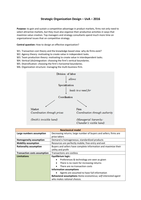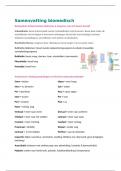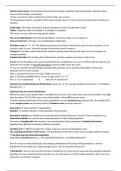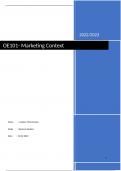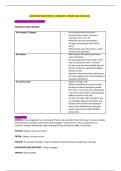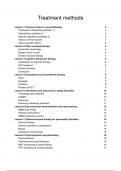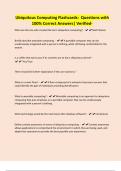Purpose: to gain and sustain a competitive advantage in product markets, firms not only need to
select attractive markets, but they must also organize their productive activities in ways that
maximize value creation. Top managers and strategy consultants spend much more time on
organizational issues that on competitive strategy.
Central question: How to design an effective organization?
W1. Transaction cost theory and the knowledge-based view: why do firms exist?
W2. Agency theory: motivating to create value in independent tasks.
W3. Team production theory: motivating to create value in interdependent tasks.
W4. Vertical (dis)integration: choosing the firm’s vertical boundaries.
W5. Diversification: choosing the firm’s horizontal boundaries.
W6. Organization structure: managing the multi-business firm.
Neoclassical model
Large numbers assumption Decreasing returns; large number of buyers and sellers; firms are
price takers
Homogeneity assumption Demand is homogeneous; standardized products
Mobility assumption Resources are perfectly mobile; free entry and exit
Rationality assumption Buyers and sellers have complete information and maximize their
utility and profit
Transaction costs assumption Transactions are costless
Limitations Equilibrium logic:
Preferences & technology are seen as given
There is no room for increasing returns
There are no transaction costs
Information assumptions
Agents are assumed to have full information
Behavioral assumptions Homo economicus; self-interested agent
who makes rational choices.
, Agents are seen as fully rational
Agents are seen as fully self-interested
View of the firm
The agent is treated as fully rational
The firm is treated as a black box
From the neoclassical model to:
1. Behavioral theory of the firm (BTOF)
o Carnegie school (not relevant for this course)
2. Contract theories about contract in governance.
o Transaction costs
o Williamson less rationality within actors, more self-interest (guile, opportunism)
o Agency theory
o Team production theory
3. Competence theories about how to change competences in capabilities, is about
production; how firms produce and outperform others.
o Evolutionary economics/theory
o Low church of the RBV
o Coorperation (relational view)
Contract theories Competence theories
Transaction cost theory Evolutionary economics
Williamson’s (1975, 1985) extension of Coase Schumpeter 1934
Transaction costs Penrose 1959
Bounded rationality Nelson & Winter 1982
Self-interested with guile (opportunism)
o Market vs hierarchy
o Asset specificity (transaction
specific investments)
o Uncertainty, small numbers,
frequency
Agency theory Jensen & Meckling 1976 Low church RBV
Shareholders are the ultimate monitors Knowledge based view (Grant 1996,
Firms as nexus of contracts Kogut & Zander 1992)
Principal – agent Capabilities based view (Dierickx & Cool
Information asymmetries 1989)
Agency costs Dynamic capabilities view (Teece et al.
o Risk attitudes 1997)
o Moral hazard
o Adverse selection
o Monitoring and bonding costs
Team production theory Alchian&Demsetz 1972
Team production
The metering problem
Monitoring costs
Residual claims
Static (efficiency) Dynamic (learning)
Allocation (value appropriation) Production (value creation)
Downplays the collective Emphasizes the collective
Ignores social relations Includes social relations
, Assumptions
Standard neoclassical economics Organization economics (‘contract’ theories)
Equilibrium Equilibrium
Firm is a unitary agent Firm is nexus for contracts
Full rationality Bounded rationality
Full information Information asymmetries
Self-interest Self-interest with guile
Firms maximize profit Managers may maximize other things
(e.g.) growth, even when they should not
Why do firms exist?, 2010
Coase: firms exist because going to the market all the time can impose heavy transaction costs.
A firm is essentially a device for creating long-term contracts when short-term contracts are
to bothersome.
These ‘firms’ (little societies) impose transaction costs of their own, which tend to rise as the
crow bigger.
Where trust in established institutions is scarce, it makes sense for companies to stretch
their brands over many industries. Where capital and labour markets are inefficient, it makes
equal sense for companies to allocate their own capital and train their own loyalties.
RBV: activities are conducted within the firm not only because markets fail, but also because
firms succeed.
Smith 1776
An inquiry into the nature and causes of the wealth of nations.
“It is not from the benevolence of the butcher, the brewer, or the baker that we expect our dinner, but
from their regard to their own interest”.
Adam Smith: provides a starting point for understanding why firms exist. Note: his arguments are
much closer to the competence theories than to contract theories.
The theory resolves around a moral claim free markets will result in maximum welfare.
o Free markets lead to perfect decentralization, which leads to social welfare.
o Free markets are efficient under the following assumptions (but are these
assumptions realistic NO..)
Rational choice
Complete markets
Full information
No monopolistic behavior
No increasing returns to scale
No externalities
Starting point of the economic theory (ET). (The invisible hand) Price mechanism leading to a free
market (perfect competition).
We get the maximum collective benefits
Markets will ultimately benefit us all because they are efficient. All (scarce) resources will
end up where they will bring the maximum value, according to their prices.
We are all free to do what we want, we just have to respond to prices and pursue our self-
interest.
The invisible hand (TIH):
TIH= competition
Competition = the market
, The market = the price mechanism
The price mechanism coordinates the actions of amoral agents in a way that maximizes social
welfare.
The division of labor:
The ‘pin-factory’.
Increase in the quantity of work the same number of people are capable of performing.
Leads to productivity increases that are the main source of the increasing ‘wealth of nations’.
Leads to an increase in productivity within a market setting.
Is pervasive in modern societies.
Coase 1937
The nature of the firm.
Purpose: bridge the gap in economic theory between the assumption that resources are allocated by
means of the price mechanism and the assumption that this allocation is dependent on the
entrepreneur-coordinator.
Main question: Why is not all economic activity coordinated by the market? Why do firms exist?
It is about efficiency, sometimes organizing within a firm, through authority (cost of
bureaucracy), is less costly than organizing through the market.
Sometimes the cost of managing economic transactions across markets is greater than the
cost of managing economic exchanges within the boundaries of an organization.
The main reason why it is profitable to establish a firm would seem to be that there is a cost
(transaction costs) of using the price mechanism.
o Finding out what relevant prices are.
o The cost of drawing up separate contracts for each market transaction (number of
contracts is reduced within the firm).
o Under some circumstances (high uncertainty), it may be hardly possible or extremely
costly to reach a contractual agreement which may serve as a basis for a market
transaction.
Outside the firm (i.e. the market), price movements directs production, which is coordinated through
a series of exchange transactions on the market. Within a firm, these market transactions are
eliminated and in place of the complicated market structure with exchange transactions is
substituted the entrepreneur-coordinating production. So, there are two types of coordination;
The market (A. Smith) Transactions can take place across markets.
The firm Transactions can take place within firms, where the entrepreneur-coordinator
allocates the factors of production between different uses.
The relative cost of transacting under the market or the firm determines which type of coordination
is used: transactions will be executed at the lowest cost. Markets and organizations are alternatives
for managing the same transactions.
The operation of the market costs something and by forming an organization and allowing some
authority (an entrepreneur) to direct the resources, certain marketing costs are saved. The
entrepreneur has to carry out his function at less costs, taking into account the fact that he may get
factors of production at a lower price that the market transactions which he supersedes, because it is
always possible to revert to the open market if he fails to do this.
Why, if organizing can eliminate certain costs, are there any market transactions at all?
As a firm gets larger, there may be decreasing returns to the entrepreneur function, the costs
of organising additional transactions within the firm may rise.
, As the transactions which are organized increase, the entrepreneur fails to place the factors
of production in the uses where their value is greatest. It fails to make best use of the factors
of production.
The supply price of one or more of the factors of production may rise, because the “other
advantages” of a small firm are greater than those of a large firm.
A firm will tend to expand until the costs of organising an extra transaction within the firm become
equal to the costs of carrying out the same transaction by means of an exchange on the open market
or the costs of organising in another firms.
Barney & Hesterly 1996
Organizational economics.
There are four major streams of research:
Transaction costs theory why do organizations exist?
Agency theory do these associated with a firm agree about how it should be managed?
Strategic management theory why do some organizations outperform others?
Cooperative organizational theory how can organizations cooperate?
Alchian & Demsetz approach:
Extension of Coase’s reasoning emphasizing measurement/metering problems as the reason
firms exist.
Measurement problems occur as a result of team production. This typically involves gains
from cooperation where complex production processes are involved. The members of the
team can produce more working cooperatively with one another than separately.
The interdependence between members yield potentially greater production, it also makes
it more difficult to assess the contribution of each individual member.
The firm emerges the need to monitor the efforts of individuals individuals are assigned to
monitoring roles, so hierarchy emerges.
Who will monitor the monitor? The firm’s stockholders; they have the claim on a firm’s
residual profits.
Williamson’s formulation of TCT:
Most highly developed alternative to Alchain & Demsetz; hierarchy arises to resolve the
problems of market governance with transaction specific investments under conditions of
uncertainty.
Two basic assumptions about the economic actors engaged in the transactions:
o Bounded rationality: those that engage in economic transactions are ‘intendedly
rational, but only limitedly so’.
o Opportunism: self-interest seeking with guile (includes lying, steeling, cheating).
The governance decision: actors will choose that form of governance (market or hierarchy)
that reduces any potential exchange problems created by bounded rationality, and the
threat of opportunism, at the lowest cost.
Attributes of transactions that will make bounded rat. and opportunism problematic:
o Uncertainty: the more uncertainty, the more difficult it will be to use contracts and
other forms of market governance to manage a transaction. It will be more likely that
hierarchical forms of governance will be adopted.
o Transaction specific investments: parties is a transaction often need to make an
investment is a specific investment in order to facilitate its completion. The greater
the difference in value between the investment’s first best due use (the current
transaction) and the second best use (another transaction), the more specific. The
existence of transaction specific investments increases the risk of opportunism. The
greater the threat of opportunism, the less likely that market governance will reduce
, this threat. More likely hierarchical forms of governance will be chosen.
Limits to using hierarchy..
Applications of the TCT:
Vertical integration
o Make or buy decisions
The multidivisional form (M-form)
o Organizing firms into either product or geographic divisions where operational
decisions and accountability for performance are placed on a division manager.
Markets, bureaucracies, clans (Ouchi, 1979/1980) forms of control.
o Markets: coordinate through prices.
o Bureaucracies: coordinate through authority and rules.
o Clans: combine authority with shared values and beliefs to effect cooperation.
The multinational enterprise
Hybrid forms of organization
o Governance structures that are neither hierarchy nor market.
o Has stronger incentives and adaptive capabilities than hierarchies while offering
more administrative control than markets.
Ouchi 1980
Markets, bureaucracies, and clans.
The TC approach allows us to identify the conditions which give rise to the costs of mediating
exchanges between individuals: goal incongruence and performance ambiguity. Different
combinations of the causes distinguish three basic mechanisms of mediation or control;
Markets: efficient when performance ambiguity is low and goals incongruence is high.
Bureaucracies: efficient when both are moderately high.
Clans: efficient when goal incongruence is low and performance ambiguity is high.
The critical element of market versus employment relations has to do with (1) ambiguity of the
measurement of individual performance, and (2) the congruence of the employees’ and employer’s
goals.
Goal incongruence: the degree to which parties to an exchange have incompatible
objectives.
Performance ambiguity: the difficulty to measure performance (the metering problem).
The fundamental problem of cooperation stems from the fact that individuals have only partially
overlapping goals. Left to their own devices, they pursue incongruent objectives and their efforts are
uncoordinated. Cooperative action necessarily involves interdependence between individuals. This
interdependence calls for a transaction or exchange in which each individual gives something of
value and receives something of value in return.
Transaction cost: any activity which is engaged in to satisfy each party to an exchange that the value
given and received is in accord with his or her expectations. demand for equity.
Arise principally when it is difficult to determine the value of the goods or services.
Their re-definition of the TCT problem: in order to mediate transactions efficiently, any
organizational form must reduce either the ambiguity of performance evaluation or the goal
incongruence between parties.
Market transactions, or exchanges, consist of contractual relationships. Each exchange is governed
by one of three types of contractual relations.
The contract must specify who must deliver what under every possible state of nature.
For succeeding with an incomplete contract, each party must trust the other to interpret the


